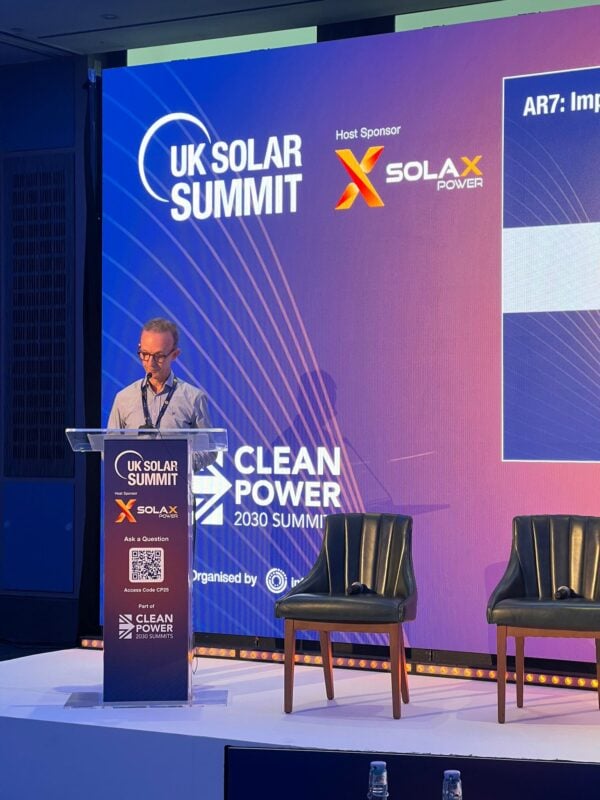
Back for the second day of the UK Solar Summit in London, the team is on the ground ready to present live coverage as the event plays out. Updates will be published here throughout the day.
Looking for the ‘holy grail’ of offtake agreements as solar deployment and negative prices grow
“The trend is clear: the sensitivity of projects to negative prices will increase,” said Stirling Habbitts, director of business development and managing director for hydrogen at Source Galileo, who moderated a discussion on the growing challenge of negative energy prices in European power. France, for instance, registered zero or negative prices for the entirety of May.
Habbitts added that this could become more of a challenge for the UK in particular, considering recent changes to the Contracts for Difference (CfD) scheme.
“Previously the CfD scheme in the UK said if prices go for negative for more than six hours you don’t get your subsidy; they’ve changed that recently and now if prices go negative for one hour or more you don’t get your subsidy [which] makes it a more severe problem,” he said. Lisa McDermott, managing director for project finance at ABN AMRO, added that some markets could see as short a timeframe as 15 minutes, as the European energy market looks to move to 15-minute price data, rather than hourly data.
“The negative hours do correlate to solar generation, but I think there’s a bit more to play,” said Aldevinas Burokas, CEO of GoldenPeaks Capital Trading. He said that energy mixes without a lot of “flexibility”, ideally through storage could struggle to effectively deal with more negative prices and more curtailment.
Aldwvinas spoke on the week that the UK government announced its much-anticipated Solar Roadmap, raising the prospect of more solar power on the UK grid in the coming years, and a resulting higher risk of price uncertainty and negative prices.
“We need to start looking holistically at what negative prices are and why they’re caused,” Burokas continued, who went on to describe a more complex form of power purchase agreement (PPA) to help minimise some of this risk.
“There is a way to structure PPAs where it’s not about sharing the risk or putting the risk on buyers or sellers, but removing the risk,” he explained. “One way to do it is to agree that when negative prices agree, you curtail … yet a developer is not producing, so you agree you will settle [with a buyer] against a P50 profile, multiplied by the PPA strike price.
“What happens on the buyers’ side is that because they’re not paying into the negative territory, they’re not exposed to negative prices. This structure seems to take into consideration all the stakeholders’ interests.”
McDermott described this offtake approach as the “holy grail” of PPAs, as it removes reliance on blunt mechanisms such as zero price floors, allows projects to continue producing without the need to curtail, and what she described as a means for big tech companies to “save” themselves from having to pay agreed-upon prices by imposing cap and floor mechanisms on producers.
Growth of co-location and hybrid projects ahead of AR7
The Low Carbon Contracts Company (LCCC) seeks to “maintain investor confidence” in next month’s Allocation Round 7 (AR7) for the next generation of Contracts for Difference (CfDs) in the UK energy market.
This was according to Neil McDermott, LCCC CEO, who spoke at the second day Solar Media’s Clean Power Summit, held this morning in London. His comments follow considerable attention paid to the financial attractiveness of the UK energy sector for investor at the first day of the event, and McDermott described the present environment as “a pivotal time in Great Britain’s energy future.”
“[The CfD process] has played a transformational role in the UK’s energy system for more than a decade now, and we’ve taken the expansion of renewables from just 6% of electricity generation in 2010 to more than 50% today,” said McDermott. “We’ve attracted more than £60 billion of private investment into the infrastructure that produces clean power.”
He added that he expects solar power to be an increasingly important part of the CfD landscape. In AR6, 3.2GW of solar capacity secured contracts, and McDermott noted that of the 130 contracts LCCC signed in the auction round, 95 were for solar projects.
“We fully expect that number of grow in AR7,” he said, looking ahead to the next auction round. “This reflects the core advantages of solar in a system transferring to net zero: it’s modular, it’s fast to build and it’s cost-competitive to build. It can be deployed at scale, on rooftops, on brownfield land and alongside storage and agrivoltaics.”
“The CfD portfolio won’t just grow, it will evolve,” he continued. “We’ll see more solar-plus-storage projects, participation from smaller developers and community-led schemes, interest in hybrid projects – combining multiple technologies under one revenues stream – and continued downward pressure on costs.”
However, when asked about the specific mechanisms for facilitating hybrid projects in the CfD scheme, particularly for co-located solar and wind projects, he said: “I don’t think they are”.
“At the moment, my best understanding is that you would have solar and onshore wind as separate technologies within the auction. Co-location at this stage is about solar with battery storage – onshore wind with battery storage is, I think less common – and I don’t think you can co-locate onshore wind and soalr at the same site with the same connection to the grid.
Considering many investors expressed confidence in the potential for both hybrid and co-located projects in discussions held on the first day of the event, particularly as a risk-management mechanism, the CfD scheme may need to introduce mechanisms for these types of projects in the auction rounds to come.

